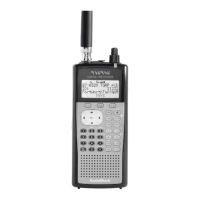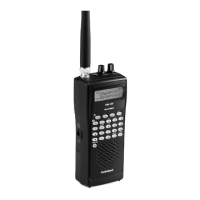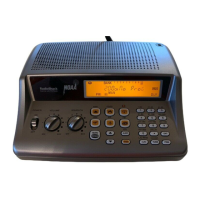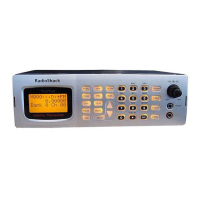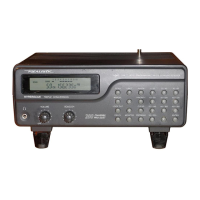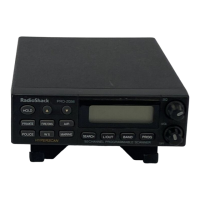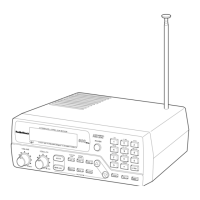Do you have a question about the Radio Shack PRO-2015 and is the answer not in the manual?
Organizes frequencies into separate fire/police, air, ham, marine, weather banks for easy searching.
Allows storage of up to 200 favorite frequencies for quick scanning and recall.
Delays scanning by two seconds after a transmission ends to hear more replies.
Stores up to 20 channels in each of 10 banks for grouping and identification.
Temporarily saves up to 20 located frequencies for later storage into channels.
Retains stored channel frequencies for about 1 hour during power loss.
Enables fast scanning and searching of frequencies up to 50 steps/sec.
Notifies user if a frequency is already stored, preventing storage duplication.
Adjusts scanner's sensitivity to receive weak signals or eliminate noise.
Allows searching for new frequencies starting from a specified frequency.
Skips specified channels or frequencies during scanning or searching.
Facilitates easy viewing and modification of programming information.
Provides methods to eliminate TV or radio interference caused by the scanner's operation.
Outlines legal requirements and prohibited transmissions for scanner users.
Lists frequencies used by ham radio operators and their typical usage.
Lists common frequencies for NOAA weather broadcasts.
Lists internal scanner frequencies that may cause interference.
Describes AM, FM, and TV audio broadcast bands monitored by the scanner.
Details typical band usage for various services like government, amateur, and public safety.
Lists frequency ranges and the services that use them, aiding scan planning.
Explains how to power the scanner using AC adapter or optional DC adapter.
Details how to install and adjust the provided telescoping antenna for optimal reception.
Identifies and explains the function of each button and control on the scanner.
Explains how channels are organized into 10 banks of 20 for grouping frequencies by service.
Describes pre-programmed banks for fire/police, aircraft, ham, and marine services for quick searching.
Guides users through powering on the scanner and setting audio levels.
Provides step-by-step instructions for programming specific frequencies into memory channels.
Details how to search pre-programmed service banks to find active frequencies.
Describes how to recall and listen to frequencies stored in the monitor memory.
Guides users on transferring frequencies from monitor memory to regular channels.
Describes how to enable or disable specific channel banks during scanning.
Explains how to continuously monitor a specific channel without scanning.
Provides steps to remove a frequency from a stored channel.
Details how to exclude specific channels or frequencies from scans to improve efficiency.
Explains how to view frequencies that have been locked out during a search.
Describes how to clear all lockout tags from frequencies within service banks.
Provides instructions to remove lockout tags from all service bank frequencies.
Explains how to program a two-second delay on channels to hear full transmissions.
Guides users on how to scan and listen to NOAA weather broadcasts.
Explains how to disable or enable the audible tone for key presses.
Outlines how different frequency bands are typically used by various services.
Highlights the main frequency ranges for government, police, fire, and railroad communications.
Details the frequency range allocated for U.S. Government communications in the UHF band.
Specifies the frequency range for 70 cm amateur radio operations.
Lists frequencies used in the UHF low band for various services.
Covers the UHF band used for TV audio broadcasts.
Suggests checking squelch and manual mode when the scanner won't scan.
Advises checking antenna and scanner location for reception issues.
Recommends resetting or reinitializing the scanner if controls are unresponsive.
Suggests checking power supply and performing resets for complete scanner failure.
Advises checking squelch and birdie frequencies for locking issues.
Describes how to perform a soft reset by using the rear panel reset button.
Explains the hard reset procedure that clears all stored memory data.
Organizes frequencies into separate fire/police, air, ham, marine, weather banks for easy searching.
Allows storage of up to 200 favorite frequencies for quick scanning and recall.
Delays scanning by two seconds after a transmission ends to hear more replies.
Stores up to 20 channels in each of 10 banks for grouping and identification.
Temporarily saves up to 20 located frequencies for later storage into channels.
Retains stored channel frequencies for about 1 hour during power loss.
Enables fast scanning and searching of frequencies up to 50 steps/sec.
Notifies user if a frequency is already stored, preventing storage duplication.
Adjusts scanner's sensitivity to receive weak signals or eliminate noise.
Allows searching for new frequencies starting from a specified frequency.
Skips specified channels or frequencies during scanning or searching.
Facilitates easy viewing and modification of programming information.
Provides methods to eliminate TV or radio interference caused by the scanner's operation.
Outlines legal requirements and prohibited transmissions for scanner users.
Lists frequencies used by ham radio operators and their typical usage.
Lists common frequencies for NOAA weather broadcasts.
Lists internal scanner frequencies that may cause interference.
Describes AM, FM, and TV audio broadcast bands monitored by the scanner.
Details typical band usage for various services like government, amateur, and public safety.
Lists frequency ranges and the services that use them, aiding scan planning.
Explains how to power the scanner using AC adapter or optional DC adapter.
Details how to install and adjust the provided telescoping antenna for optimal reception.
Identifies and explains the function of each button and control on the scanner.
Explains how channels are organized into 10 banks of 20 for grouping frequencies by service.
Describes pre-programmed banks for fire/police, aircraft, ham, and marine services for quick searching.
Guides users through powering on the scanner and setting audio levels.
Provides step-by-step instructions for programming specific frequencies into memory channels.
Details how to search pre-programmed service banks to find active frequencies.
Describes how to recall and listen to frequencies stored in the monitor memory.
Guides users on transferring frequencies from monitor memory to regular channels.
Describes how to enable or disable specific channel banks during scanning.
Explains how to continuously monitor a specific channel without scanning.
Provides steps to remove a frequency from a stored channel.
Details how to exclude specific channels or frequencies from scans to improve efficiency.
Explains how to view frequencies that have been locked out during a search.
Describes how to clear all lockout tags from frequencies within service banks.
Provides instructions to remove lockout tags from all service bank frequencies.
Explains how to program a two-second delay on channels to hear full transmissions.
Guides users on how to scan and listen to NOAA weather broadcasts.
Explains how to disable or enable the audible tone for key presses.
Outlines how different frequency bands are typically used by various services.
Highlights the main frequency ranges for government, police, fire, and railroad communications.
Details the frequency range allocated for U.S. Government communications in the UHF band.
Specifies the frequency range for 70 cm amateur radio operations.
Lists frequencies used in the UHF low band for various services.
Covers the UHF band used for TV audio broadcasts.
Suggests checking squelch and manual mode when the scanner won't scan.
Advises checking antenna and scanner location for reception issues.
Recommends resetting or reinitializing the scanner if controls are unresponsive.
Suggests checking power supply and performing resets for complete scanner failure.
Advises checking squelch and birdie frequencies for locking issues.
Describes how to perform a soft reset by using the rear panel reset button.
Explains the hard reset procedure that clears all stored memory data.
| Type | Base/Mobile Scanner |
|---|---|
| Modulation Types | AM, FM, WFM |
| Channel Capacity | 200 Channels |
| Memory | 10 Banks |
| Frequency Range | 29-54 MHz, 108-174 MHz, 406-512 MHz |


